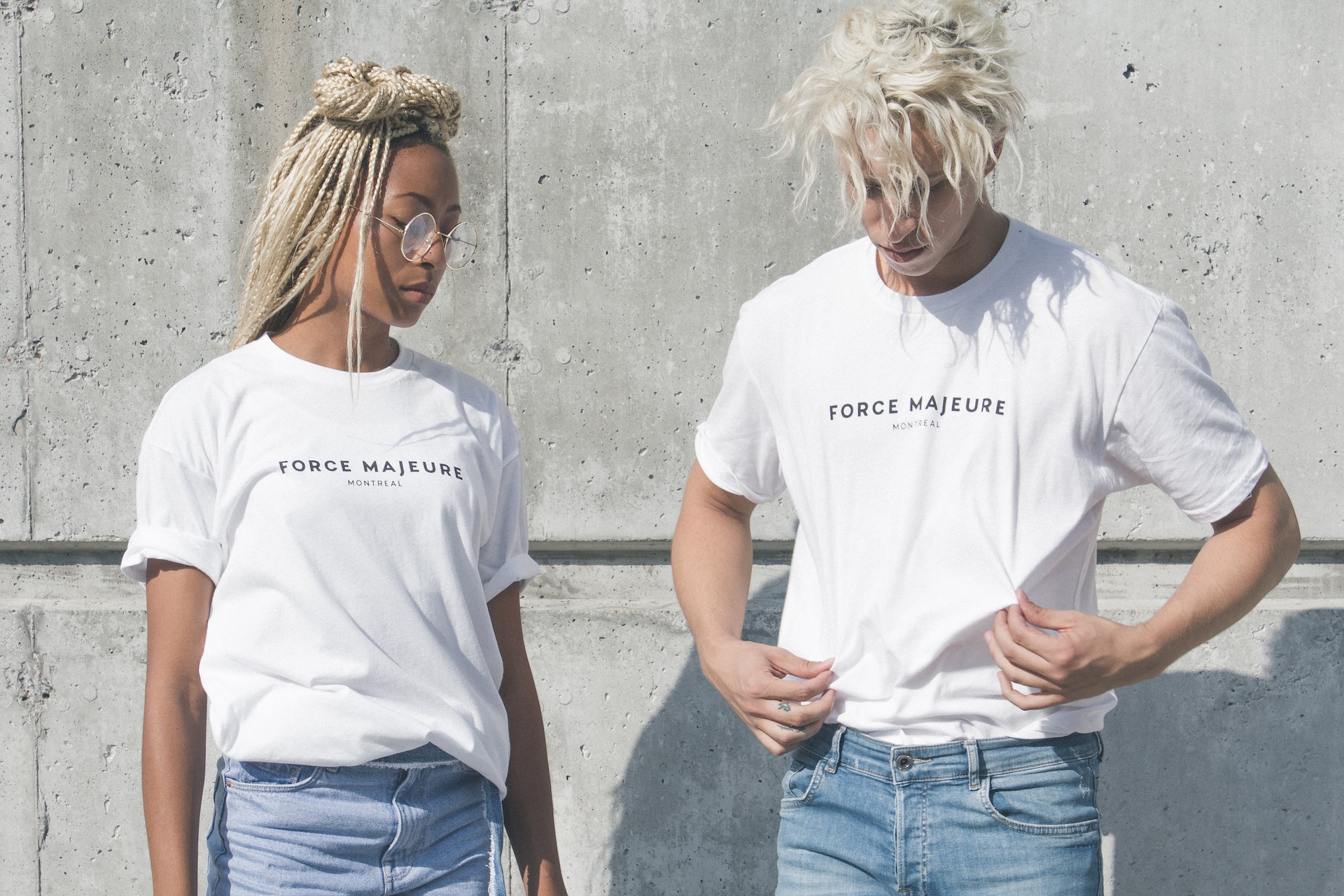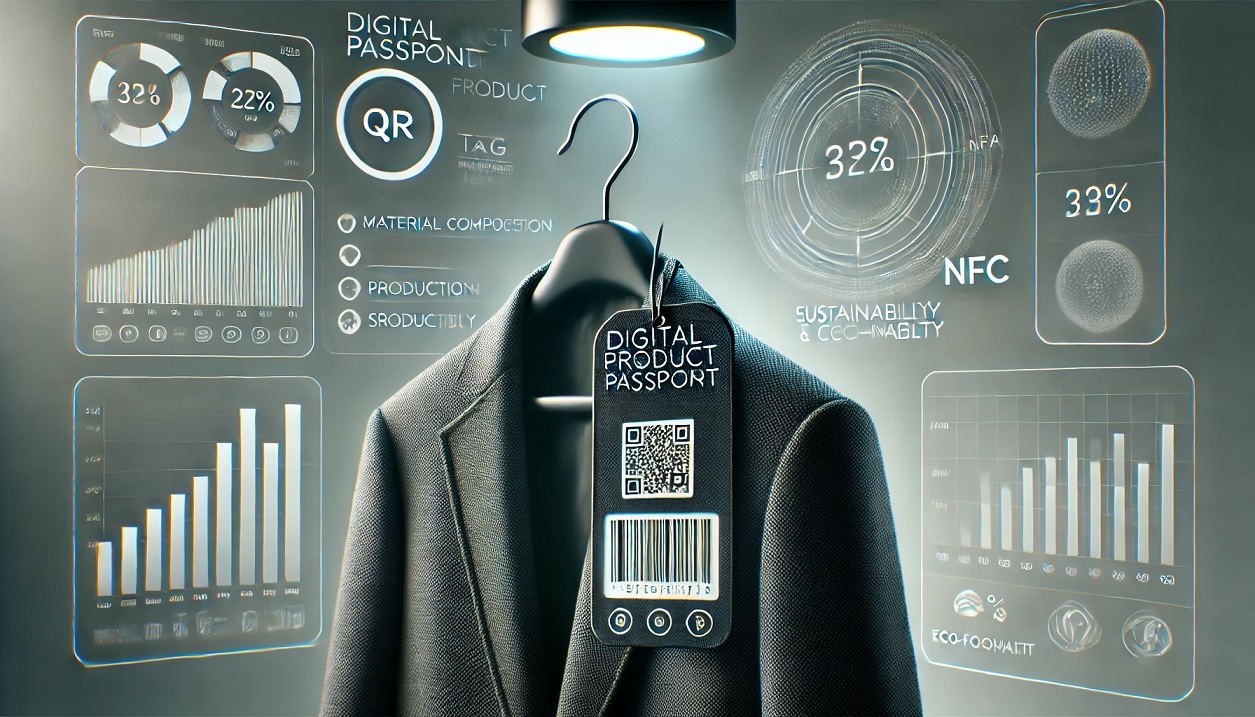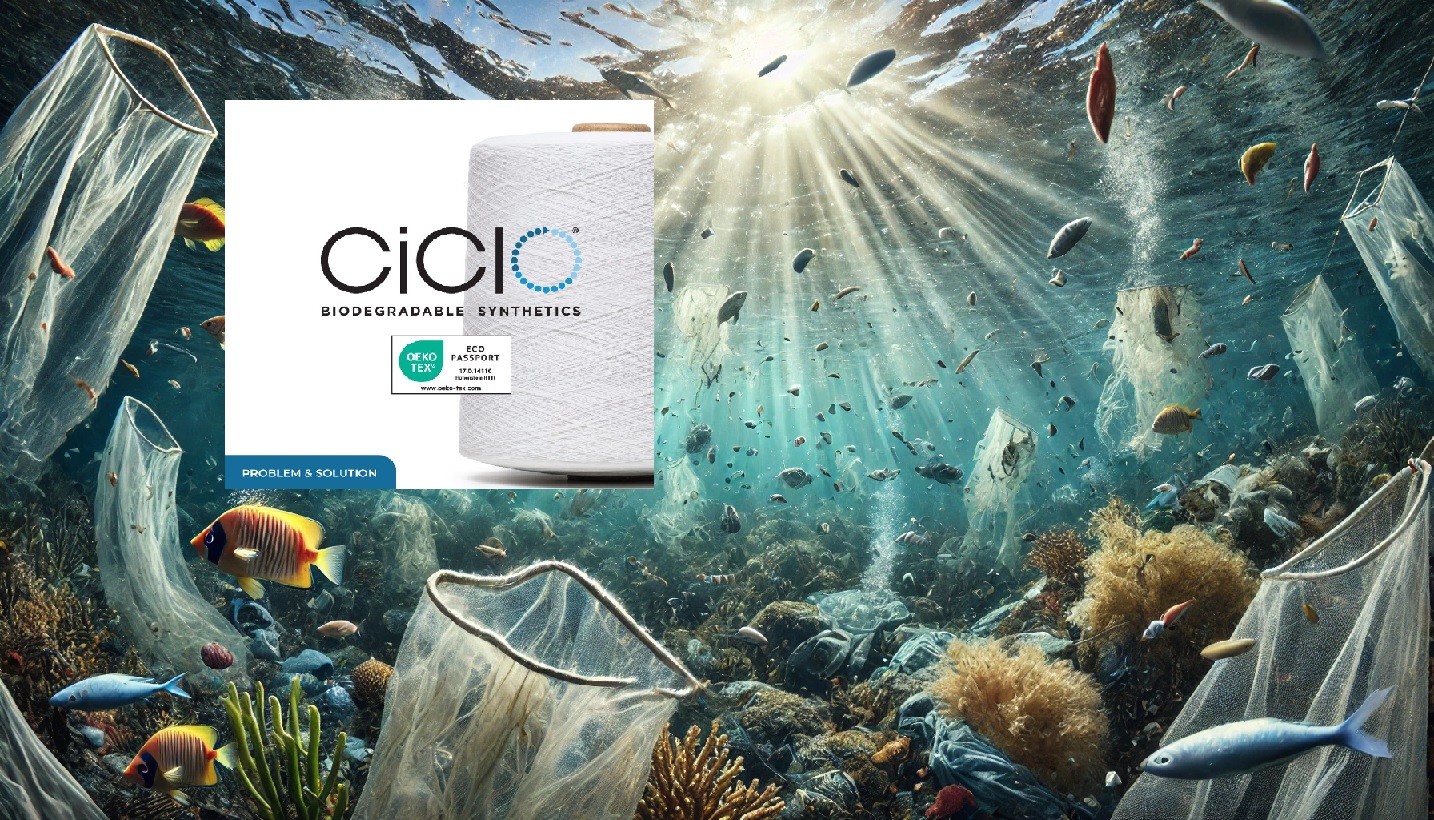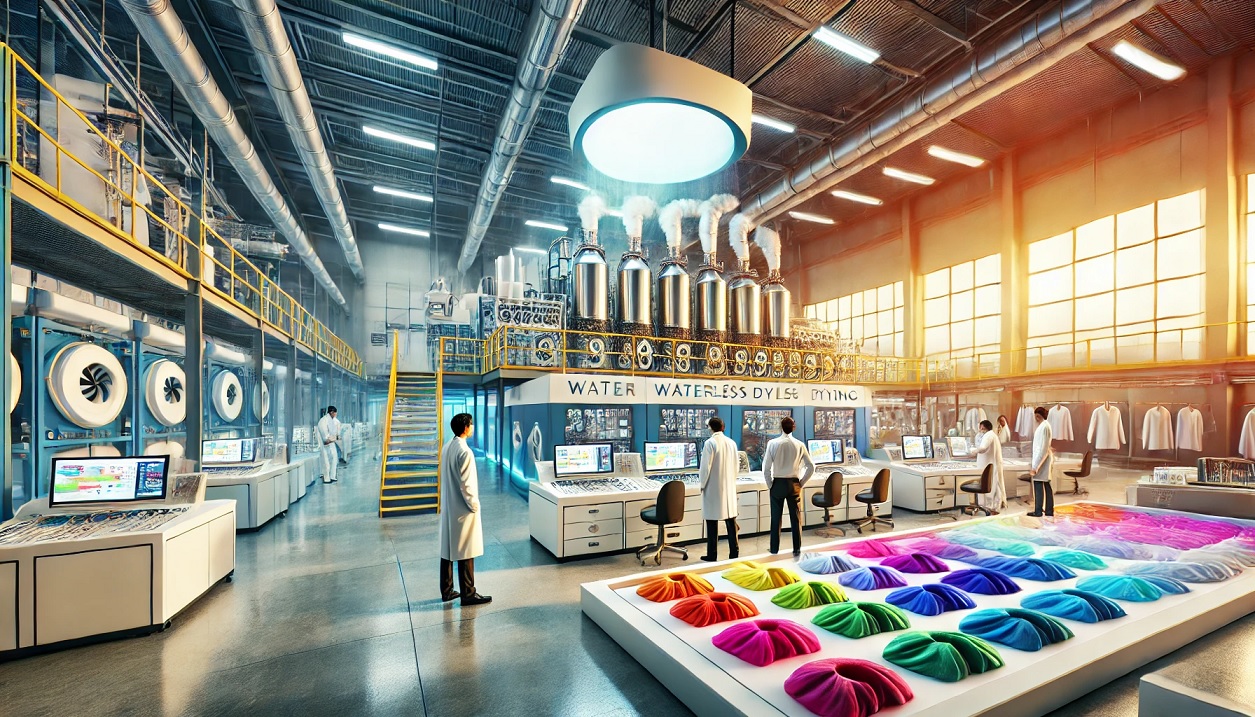The textile industry is one of the most important sectors in the world, providing clothing, fabrics, and other products that are essential for human well-being. However, it is also one of the most polluting and wasteful industries, consuming huge amounts of natural resources, generating tons of greenhouse gas emissions, and creating millions of tons of textile waste every year.
How can we make the textile industry more sustainable and circular? How can we reduce the environmental and social impacts of textile production and consumption? How can we create a system where textiles are designed, used, and disposed of in a way that preserves their value and minimizes their harm to the planet and people?
In this ultimate guide, we will answer these questions and more. We will introduce you to the concept of circular textiles, explain why they are important, and show you how they work. We will also explore the benefits and challenges of circular textiles, as well as the innovations and trends that are shaping their future. By the end of this guide, you will have a better understanding of circular textiles and how they can transform the textile industry for the better.
Introduction to Circular Textiles
What are Circular Textiles?
Circular textiles are textiles that follow the principles of a circular economy, which is an economic system that aims to eliminate waste and pollution, keep products and materials in use, and regenerate natural systems. A circular economy is based on three main strategies: reduce, reuse, and recycle.
Reduce means using less resources and energy to produce textiles, as well as designing them to last longer and require less maintenance. Reuse means extending the lifespan of textiles by repairing them, sharing them, or repurposing them for other uses. Recycle means recovering the materials from used textiles and turning them into new products or raw materials.
Circular textiles are therefore textiles that are designed for durability, repairability, and recyclability (DRR). They are made from renewable or recycled materials that have minimal environmental impact. They are used in a way that maximizes their value and minimizes their waste. And they are recycled or composted at the end of their life cycle, ensuring that nothing is lost or wasted.
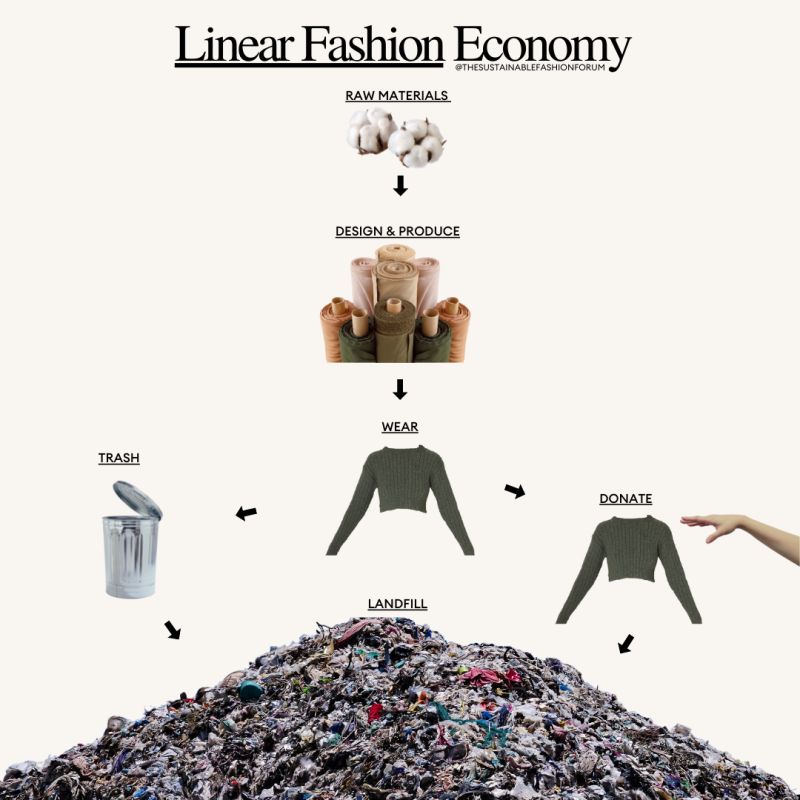
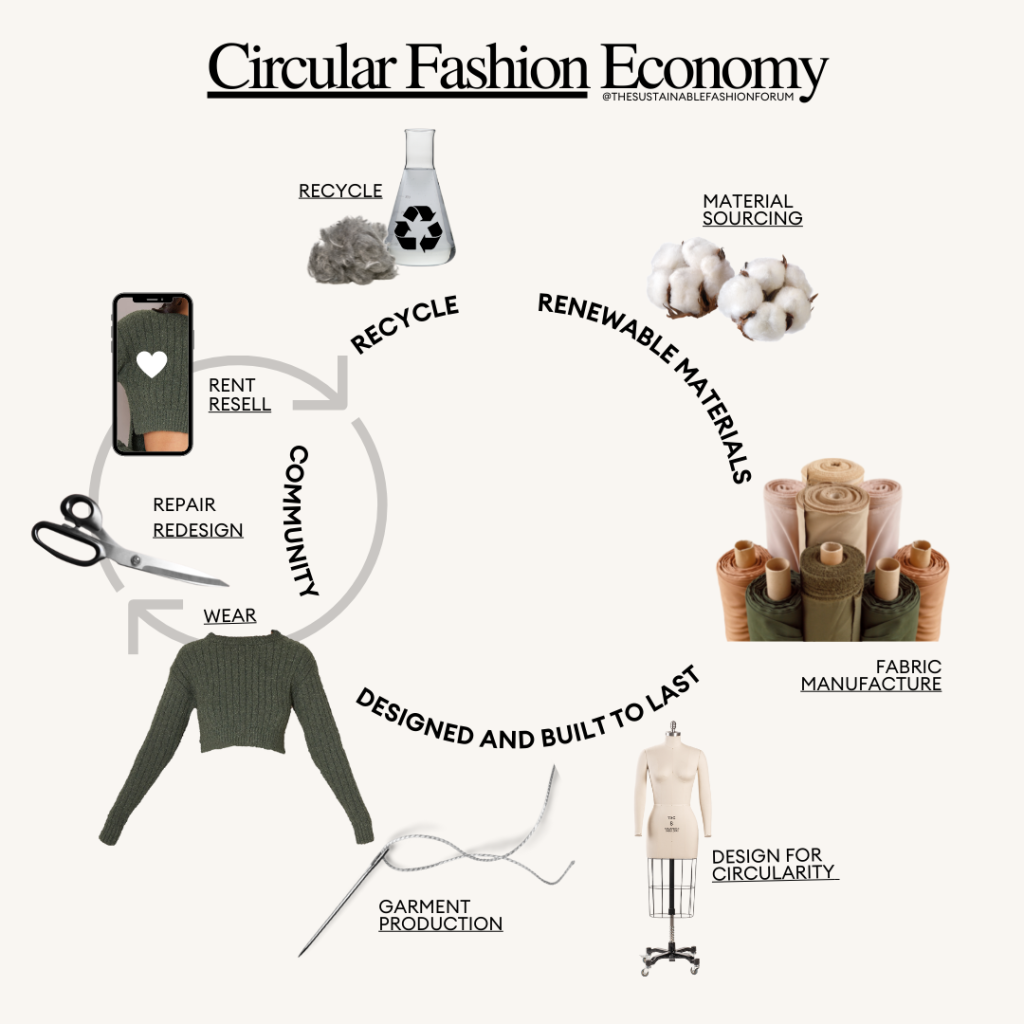
Image: sustainable fashion forum
Why are Circular Textiles Important?
Circular textiles are important for several reasons. First, they can help address the environmental challenges posed by the current linear textile system, which is based on a take-make-waste model. The linear system consumes large amounts of water, energy, land, and chemicals to produce textiles from virgin materials. It also generates significant amounts of greenhouse gas emissions, water pollution, soil degradation, biodiversity loss, and toxic waste. According to a report by the Ellen MacArthur Foundation. the global textile industry is responsible for:
- 2.1 billion tonnes of greenhouse gas emissions per year, equivalent to 4% of global emissions
- 93 billion cubic meters of water consumption per year, equivalent to 4% of global water withdrawal
- 20% of global industrial water pollution from dyeing and finishing processes
- 92 million tonnes of textile waste per year

Circular textiles can help reduce these impacts by using less resources and energy, avoiding harmful chemicals and substances, minimizing waste generation and emissions, and restoring natural capital.
Second, circular textiles can also create economic opportunities and social benefits for various stakeholders along the textile value chain. For example:
- Producers can save costs by using less inputs and reducing waste. They can also access new markets by offering more sustainable products and services.
- Consumers can enjoy higher quality products that last longer and perform better. They can also save money by repairing or renting their clothes instead of buying new ones.
- Recyclers can generate revenue by recovering valuable materials from used textiles. They can also create jobs by employing skilled workers for sorting and processing activities.
- Policymakers can support innovation and competitiveness by creating enabling frameworks and incentives for circular textiles. They can also improve public health and well-being by reducing environmental pollution and social inequalities.
According to another report by the Ellen MacArthur Foundation, shifting to a circular economy for textiles could unlock $560 billion of economic value by 2030.
The Journey of Circular Textiles
From Production to Consumption
The journey of circular textiles starts from the production stage, where raw materials are sourced or recycled to create fibres and fabrics. There are two main types of fibres: natural fibres (such as cotton, wool, silk) and synthetic fibres (such as polyester, nylon). Natural fibres come from plants or animals, while synthetic fibres are made from petroleum or other chemicals.
In a circular economy, both types of fibres should be produced in a way that minimizes their environmental impact and maximizes their quality. For natural fibres, this means using organic or regenerative farming practices that avoid pesticides, fertilizers, irrigation, and deforestation. For synthetic fibres, this means using recycled or bio-based materials that reduce dependence on fossil fuels and prevent microplastic pollution.
The fibres are then spun, woven, knitted, or nonwoven into fabrics, which are then dyed, printed, and finished to give them the desired color, pattern, and functionality. In a circular economy, these processes should also be done in a way that minimizes their environmental impact and maximizes their quality. For example, this means using natural or low-impact dyes that do not contain harmful chemicals or heavy metals. It also means using waterless or low-water technologies that reduce water consumption and pollution.
The fabrics are then cut, sewn, and assembled into garments or other textile products, which are then distributed to the market. In a circular economy, these products should be designed for durability, repairability, and recyclability. For example, this means using high-quality materials that resist wear and tear. It also means using modular or reversible designs that allow for easy customization or adaptation. And it means using standardized or compatible components that facilitate disassembly and separation.
The products are then sold to the consumers, who use them for their intended purposes. In a circular economy, the consumers should use the products in a way that maximizes their value and minimizes their waste. For example, this means wearing the products for longer and taking good care of them. It also means repairing the products when they get damaged or worn out. And it means sharing or renting the products when they are not needed or wanted.
The Role of Recycling in Circular Textiles
The journey of circular textiles does not end with the consumption stage. When the products reach the end of their useful life, they can still be recycled into new materials or products, instead of being thrown away or incinerated. Recycling is an essential part of a circular economy, as it helps to keep the materials in circulation and avoid wasting their value.
However, recycling is not a simple or straightforward process. It involves several steps and challenges that need to be overcome to ensure its effectiveness and efficiency. Some of these steps and challenges are:
- Collection: The first step is to collect the used textiles from the consumers and transport them to the recycling facilities. This requires a well-developed and convenient infrastructure and system that can capture the textiles in a clean and dry condition. It also requires a high level of consumer awareness and participation that can motivate them to return their textiles instead of discarding them.
- Sorting: The second step is to sort the collected textiles according to their fibre type, color, quality, and condition. This requires a reliable and accurate method that can identify the composition and characteristics of the textiles. It also requires a harmonized and consistent standard and criteria that can facilitate the sorting process.
- Processing: The third step is to process the sorted textiles into new materials or products. This requires a suitable and scalable technology that can handle different types of fibres and fabrics. It also requires a high-quality and high-volume feedstock that can ensure the performance and functionality of the recycled materials or products.
- Marketing: The fourth step is to market the recycled materials or products to the consumers or other stakeholders. This requires a strong and transparent communication strategy that can convey the benefits and features of the recycled materials or products. It also requires a supportive and enabling policy framework that can create incentives and demand for the recycled materials or products.
Benefits of Circular Textiles
Environmental Impact
One of the main benefits of circular textiles is their positive impact on the environment. By reducing resource consumption, waste generation, emissions, and pollution, circular textiles can help mitigate climate change, conserve water resources, protect soil health, preserve biodiversity, and improve air quality.
According to a study by McKinsey & Company, adopting circular practices in the textile industry could reduce greenhouse gas emissions by 56%, water consumption by 28%, land use by 22%, chemical use by 19%, waste generation by 17%, energy use by 15%, and microplastic pollution by 14% by 2030.
These reductions could translate into significant environmental benefits for both humans and nature. For example:
- Reducing greenhouse gas emissions could help limit global warming and its associated impacts such as extreme weather events, sea level rise, heat waves, droughts, floods, wildfires, crop failures, food insecurity, disease outbreaks, migration crises, conflicts, and displacement.
- Reducing water consumption could help alleviate water scarcity and stress in many regions of the world where water resources are limited or overexploited. It could also help improve water quality and availability for drinking, sanitation, agriculture, industry, recreation, and ecosystem services.
- Reducing land use could help prevent deforestation and land degradation in many areas where natural habitats are converted or degraded for agricultural or industrial purposes. It could also help restore soil fertility and productivity
- Reducing chemical use could help avoid toxic contamination of water bodies, soil organisms, plants, animals, and humans. It could also help reduce health risks and costs associated with exposure to hazardous substances such as cancer, allergies, respiratory problems, skin irritations, and reproductive disorders.
- Reducing waste generation could help reduce landfilling and incineration of textiles, which can cause environmental problems such as leachate, methane emissions, odors, fires, and ash. It could also help save space and resources that could be used for other purposes.
- Reducing energy use could help reduce dependence on fossil fuels and their associated impacts such as greenhouse gas emissions, air pollution, oil spills, and resource depletion. It could also help increase energy security and efficiency by using renewable or low-carbon sources of energy.
- Reducing microplastic pollution could help prevent the accumulation of tiny plastic particles in the oceans, rivers, lakes, soils, and air. It could also help protect marine life and human health from the ingestion or inhalation of microplastics, which can carry harmful chemicals or pathogens.
Economic Benefits
Another benefit of circular textiles is their positive impact on the economy. By creating new markets, products, services, jobs, and value, circular textiles can help boost economic growth, innovation, competitiveness, and resilience.
According to a study by the World Economic Forum, adopting circular practices in the textile industry could create $500 billion of additional value by 2030. This value could come from various sources such as:
- Cost savings: Circular textiles can help reduce the costs of production and consumption by using less resources and energy, avoiding waste and emissions, and extending the lifespan of products. For example, using recycled fibres instead of virgin fibres can save up to 60% of energy costs and 94% of water costs. Repairing clothes instead of buying new ones can save up to 80% of material costs.
- Revenue generation: Circular textiles can help generate new revenue streams by creating new products and services that meet the needs and preferences of consumers and other stakeholders. For example, selling or renting used clothes instead of discarding them can create a lucrative market for second-hand or rental fashion. Producing or selling recycled materials or products can create a profitable market for circular materials or products.
- Job creation: Circular textiles can help create new jobs by requiring more skilled labor for activities such as sorting, repairing, recycling, designing, and innovating. For example, recycling one tonne of textiles can create up to 10 jobs. Repairing clothes instead of buying new ones can create up to 40 jobs per tonne.
- Value creation: Circular textiles can help create more value by enhancing the quality and functionality of products and materials. For example, designing products for durability and repairability can improve their performance and appearance. Recycling materials into new products can increase their functionality and diversity.
Challenges in Circular Textiles
Production Challenges
Despite the benefits of circular textiles, there are also some challenges that need to be overcome to achieve their full potential. One of these challenges is related to the production stage of circular textiles.
One of the main production challenges is the lack of availability and affordability of circular materials. Although there are some examples of renewable or recycled fibres that are commercially available (such as organic cotton, recycled polyester, lyocell), they still represent a small fraction of the total fibre market (less than 10%). Moreover, they often face higher costs or lower quality compared to conventional fibres due to factors such as limited supply, high demand, low yield, complex processing, or quality degradation. Therefore, there is a need to increase the production and availability of circular materials, as well as to reduce their costs and improve their quality.
Another production challenge is the lack of compatibility and standardization of circular materials. Due to the diversity and variability of fibre types, colors, qualities, and conditions, it is often difficult to mix and match different materials or to ensure their consistency and compatibility. This can affect the performance and functionality of the final products or materials. Therefore, there is a need to develop and adopt common standards and criteria for circular materials, as well as to improve their compatibility and interoperability.
A third production challenge is the lack of innovation and technology for circular materials. Although there are some existing technologies that can produce or process circular materials (such as mechanical or chemical recycling, waterless dyeing, digital printing), they often face limitations or barriers such as low efficiency, high energy consumption, high environmental impact, low quality output, or high capital investment. Therefore, there is a need to innovate and develop new technologies that can overcome these limitations or barriers and enable more efficient and effective production of circular materials.
Consumer Awareness and Behavior
Another challenge that needs to be overcome to achieve the full potential of circular textiles is related to the consumption stage of circular textiles.
One of the main consumption challenges is the lack of consumer awareness and education about circular textiles. Many consumers are not aware of the environmental and social impacts of their textile choices, or of the benefits and opportunities of circular textiles. They may also have misconceptions or prejudices about circular textiles, such as thinking that they are inferior in quality, style, or comfort. Therefore, there is a need to increase consumer awareness and education about circular textiles, as well as to dispel any myths or stereotypes about them.
Another consumption challenge is the lack of consumer demand and preference for circular textiles. Even if consumers are aware of circular textiles, they may not be willing or able to buy them due to factors such as price, availability, convenience, or habit. They may also be influenced by external factors such as fashion trends, social norms, peer pressure, or marketing strategies that encourage them to buy more and newer products. Therefore, there is a need to increase consumer demand and preference for circular textiles, as well as to create incentives and nudges that can motivate them to choose them.
A third consumption challenge is the lack of consumer participation and engagement in circular textiles. Even if consumers buy circular textiles, they may not use them in a way that maximizes their value and minimizes their waste. They may not take good care of them, repair them when needed, share them with others, or return them for recycling when they are no longer wanted. They may also lack the skills or tools to do so. Therefore, there is a need to increase consumer participation and engagement in circular textiles, as well as to provide them with the skills and tools that can enable them to do so.
The Future of Circular Textiles
Innovations and Trends
Despite the challenges that exist in achieving the full potential of circular textiles, there are also some innovations and trends that are shaping their future. These innovations and trends are driven by various factors such as technological advancements, market opportunities, consumer preferences, policy regulations, and social movements. Some of these innovations and trends are:
- New materials and technologies: There are many new materials and technologies that are being developed or improved to enable more circular textiles. For example, there are bio-based or biodegradable fibres that can be made from renewable sources such as algae, fungi, or bacteria. There are also smart or functional fibres that can change their properties or performance according to external stimuli such as temperature, light, or moisture. Moreover, there are digital or additive technologies that can create customized or personalized products or materials on demand, such as 3D printing, laser cutting, or digital knitting.
- New business models and services: There are also new business models and services that are being created or expanded to enable more circular textiles. For example, there are circular platforms or networks that can connect different stakeholders along the textile value chain, such as producers, consumers, recyclers, or innovators. There are also circular services or solutions that can offer more value and convenience to consumers, such as repair, rental, subscription, or resale services.
- New policies and regulations: There are also new policies and regulations that are being implemented or proposed to enable more circular textiles. For example, there are extended producer responsibility (EPR) schemes that can require producers to take back or recycle their products or materials at the end of their life cycle. There are also bans or taxes on single-use or non-recyclable products or materials, such as plastic bags, straws, or microbeads. Furthermore, there are standards or labels that can inform consumers about the environmental or social performance of products or materials, such as the Global Organic Textile Standard (GOTS), the Recycled Claim Standard (RCS), or the Fair Trade Certified label.
- New movements and initiatives: There are also new movements and initiatives that are being launched or supported to enable more circular textiles. For example, there are campaigns or events that can raise awareness and education about circular textiles, such as the Fashion Revolution Week, the Global Recycling Day, or the Circular Fashion Games. There are also collaborations or partnerships that can foster innovation and cooperation among different stakeholders, such as the Circular Fibres Initiative, the Textile Exchange, or the Fashion for Good.
These innovations and trends indicate that circular textiles have a bright and promising future ahead of them. They also show that circular textiles are not only a technical or economic issue, but also a social and cultural one. They require not only new materials and technologies, but also new mindsets and behaviors.
Policy and Regulation
One of the factors that can influence the future of circular textiles is policy and regulation. Policy and regulation can play a key role in enabling or hindering the transition to a circular economy for textiles. They can create incentives or disincentives for different stakeholders to adopt circular practices. They can also set standards or rules for the production and consumption of circular textiles.
However, policy and regulation can also pose some challenges for circular textiles. One of these challenges is related to the complexity and diversity of policy and regulation across different regions across different regions and countries. The textile industry is a global and interconnected sector that involves many actors and activities across different stages and locations. However, the policy and regulation that govern the textile industry are often fragmented and inconsistent across different jurisdictions and levels. This can create confusion, uncertainty, or inconsistency for the stakeholders involved in circular textiles. It can also create barriers or loopholes for the implementation or enforcement of circular practices. Therefore, there is a need to harmonize and coordinate policy and regulation across different regions and countries, as well as to align them with the principles and goals of a circular economy.
Another challenge is related to the trade-offs and conflicts that may arise from policy and regulation. Policy and regulation can have different impacts on different stakeholders, depending on their interests, preferences, or capacities. For example, policy and regulation that aim to promote circular textiles may benefit producers or consumers who are willing or able to adopt circular practices, but they may also harm producers or consumers who are not willing or able to do so. They may also affect other sectors or issues that are related or unrelated to circular textiles, such as energy, agriculture, trade, or human rights. Therefore, there is a need to balance and integrate policy and regulation across different dimensions and perspectives, as well as to address any trade-offs or conflicts that may arise from them.
Conclusion
Circular textiles are textiles that follow the principles of a circular economy, which is an economic system that aims to eliminate waste and pollution, keep products and materials in use, and regenerate natural systems. Circular textiles are designed for durability, repairability, and recyclability. They are made from renewable or recycled materials that have minimal environmental impact. They are used in a way that maximizes their value and minimizes their waste. And they are recycled or composted at the end of their life cycle, ensuring that nothing is lost or wasted.
Circular textiles have many benefits for the environment, the economy, and the society. They can help reduce the environmental impacts of textile production and consumption, such as greenhouse gas emissions, water consumption, land use, chemical use, waste generation, energy use, and microplastic pollution. They can also help create economic opportunities and social benefits for various stakeholders along the textile value chain, such as cost savings, revenue generation, job creation, and value creation.
However, circular textiles also face some challenges that need to be overcome to achieve their full potential. These challenges are related to the production and consumption stages of circular textiles. Some of these challenges are: the lack of availability and affordability of circular materials; the lack of compatibility and standardization of circular materials; the lack of innovation and technology for circular materials; the lack of consumer awareness and education about circular textiles; the lack of consumer demand and preference for circular textiles; the lack of consumer participation and engagement in circular textiles.
The future of circular textiles is shaped by various innovations and trends that are driven by technological advancements, market opportunities, consumer preferences, policy regulations, and social movements. These innovations and trends include new materials and technologies, new business models and services, new policies and regulations, and new movements and initiatives. These innovations and trends indicate that circular textiles have a bright and promising future ahead of them. They also show that circular textiles are not only a technical or economic issue, but also a social and cultural one. They require not only new materials and technologies, but also new mindsets and behaviors.
Circular textiles are therefore an important and relevant topic for anyone who is interested in the textile industry, the circular economy, or the sustainability of our planet and society. By learning more about circular textiles, we can gain a better understanding of the challenges and opportunities that they present. By adopting more circular practices, we can contribute to the transition to a more sustainable and circular textile system. And by sharing our knowledge and experience, we can inspire others to join us in this journey.
FAQs
Here are some frequently asked questions (FAQs) about circular textiles:
- What are some examples of circular textiles? Some examples of circular textiles are: jeans made from recycled denim; sweaters made from wool that is regenerated from old garments;
- How can I buy circular textiles? You can buy circular textiles by looking for products or brands that have certifications or labels that indicate their circularity. For example, you can look for products or brands that have the Global Recycled Standard (GRS). You can also look for products or brands that offer circular services or solutions, such as repair, rental, subscription, or resale services.
- How can I use circular textiles? You can use circular textiles by taking good care of them, repairing them when needed, sharing them with others, or returning them for recycling when they are no longer wanted. You can also use circular textiles by choosing products or materials that suit your needs and preferences, customizing or personalizing them according to your style or taste, or adapting them for different purposes or occasions.
- How can I recycle circular textiles? You can recycle circular textiles by returning them to the producers or retailers who offer take-back or recycling schemes. You can also recycle circular textiles by donating them to charities or organizations who collect and sort them for recycling. Alternatively, you can recycle circular textiles by sending them to recyclers who process them into new materials or products.
- How can I learn more about circular textiles? You can learn more about circular textiles by reading books, articles, reports, or blogs that cover the topic of circular textiles. You can also learn more about circular textiles by watching videos, podcasts, webinars, or documentaries that feature the topic of circular textiles. Moreover, you can learn more about circular textiles by attending courses, workshops, events, or conferences that offer education or training on the topic of circular textiles.
Further Sources of Information
If you are interested in reading more about circular textiles, I can recommend some books, articles, reports, or blogs that cover the topic in depth. For example, you can read:
- A New Textiles Economy: Redesigning Fashion’s Future, a report by the Ellen MacArthur Foundation that outlines a vision and action plan for a circular economy for textiles.
- Sustainable fashion in textile economy.
- The State of Fashion 2020: Coronavirus Update, a report by McKinsey & Company and The Business of Fashion that explores the impact of the COVID-19 pandemic on the fashion industry and the opportunities for circularity and resilience.
